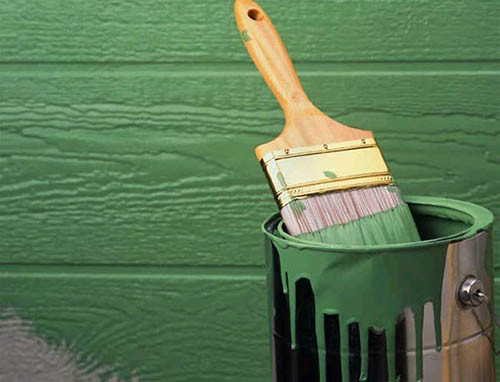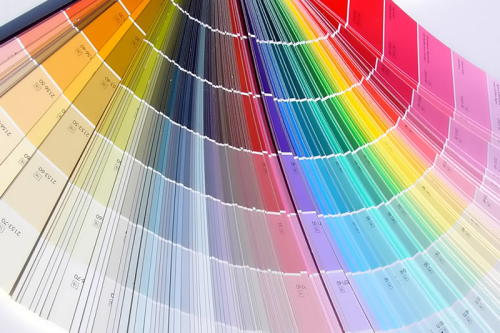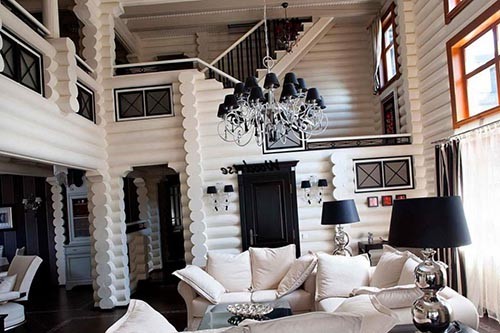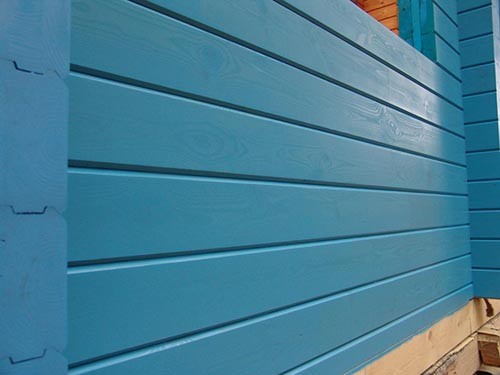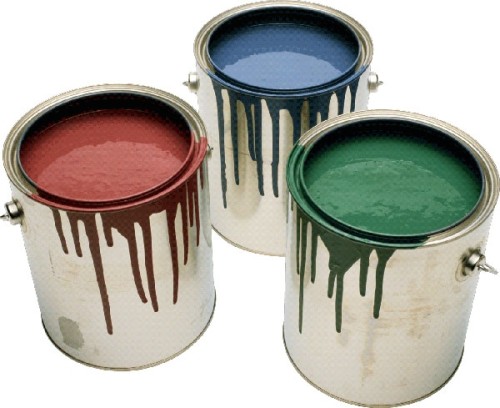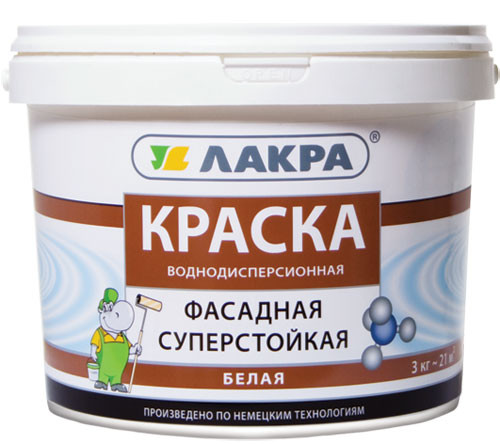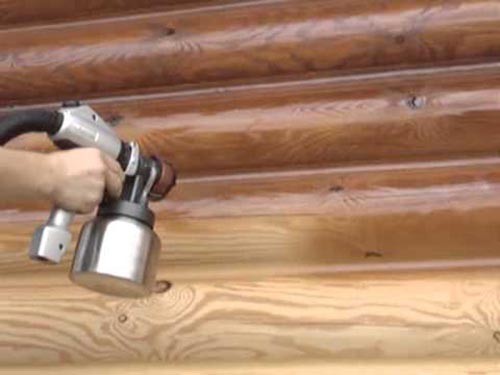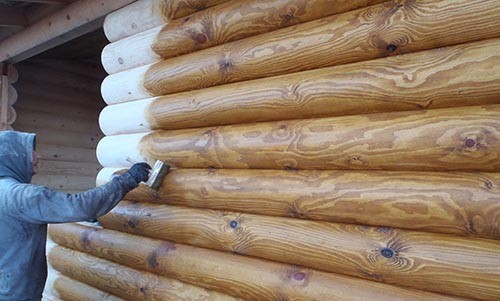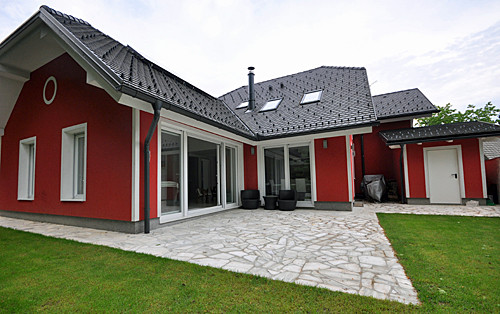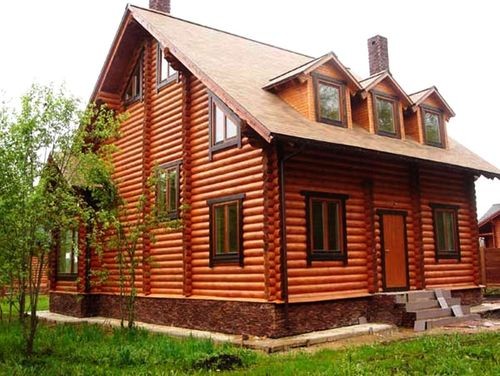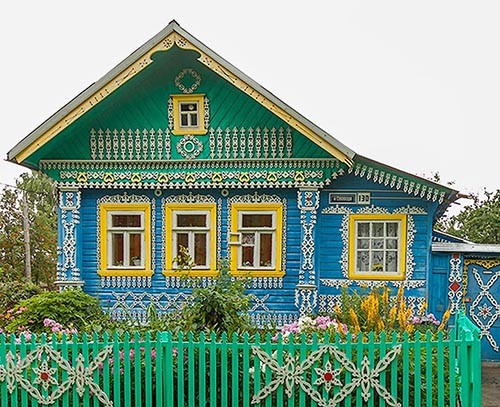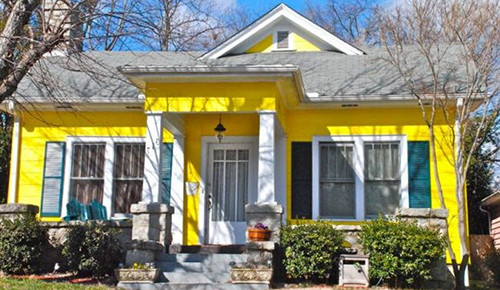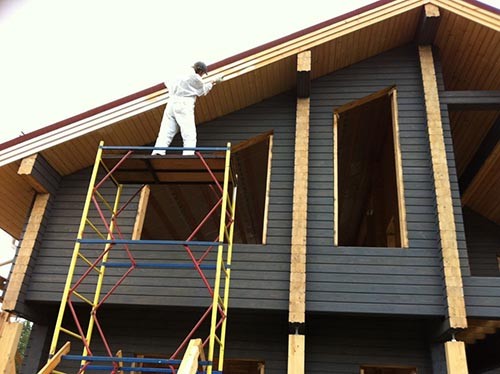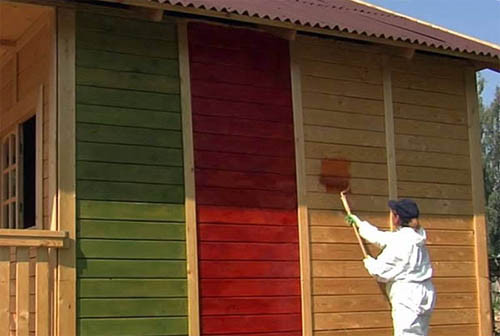Wood is a living material, so over time it begins to age and loses its original beautiful view. There are many reasons for aging: ultraviolet radiation from the sun, precipitation and temperature fluctuations.
In addition, the building is constantly affected by biological threats: the wood can suffer from rot and mold, it is destroyed by wood-boring beetles, blueweed and other pests. To update the appearance of the building, you can paint old house using modern materials.
What products can be used for old wood?
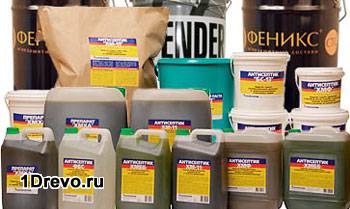
Answers to the question of how to paint an old one log house, can be quite a lot: it is important not only to create a new decorative coating, but also to protect the wood from further destruction by various threats. In this regard, painting an old log house means providing a multi-layer treatment using several types of products. To fully protect your home you will need:
- Antiseptics. These are deep penetration products (up to 7 mm) that allow you to protect your home from rot, mold and other biological threats.
For an old house, they are simply necessary, as they allow you to restore the tree by removing pockets of infection. The choice of antiseptics is quite wide; you can purchase European or Russian products.
- Wood bleaches. They are needed only if the logs have become very dark over time and have completely lost their appearance.
There are also quite a lot of such funds; as an example, we can name “Senezh Effo”. They are expensive, so professional bleaches can be replaced with regular “Whiteness” - a chlorine-containing composition can also give good results.
- Facade putties are necessary in order to completely close cracks in logs. Wood tends to crack when it dries out or during shrinkage, and if the cracks are not closed in time, this can lead to a decrease in the strength of the log and its load-bearing capacity. Putty will help cover the affected area.
- Preparing old wood for painting ends with the application of a façade primer. This substance also penetrates deeply into the wood structure, leveling the surface. If you pre-treat the wood with a primer, the paint will go on smoother and you will need much less materials for painting.
When deciding how to paint the outside of an old house, it is better to avoid glazing compounds unless complete pre-treatment with bleach is intended. Translucent colors will only emphasize dark color old wood, which does not add beauty to the house at all. It is better to spare no expense in completely restoring the external appearance of the building.
Types of paints for exterior home treatment
What paint to paint an old house? After pre-treatment, the building will be ready for final painting, for which you need to choose the right composition. For the exterior treatment of a wooden building, the following types of paint compositions can be used:
- Oil paints. This is a traditional option that is becoming less and less common these days. They are quite durable; the paint layer will last for at least 6 years without major changes, since they penetrate deeply into the wood.
But they have a number of disadvantages: oil-based paint takes a very long time to dry, and the specific smell makes working with it very unpleasant. In addition, it is very difficult to apply evenly: most often, unsightly streaks remain on the wood.
- Acrylic paints are the most modern popular option. They form an even layer with a pleasant shine; such paints will make the wood truly alive.
At the same time, it will be very convenient to work with them, the coating dries quickly, and in the future it will not get dirty. Acrylic paints can be considered the most profitable solution today.
- Alkyd paints are another popular solution. They are made on the basis of alkyd resins: the finished coating will have a water-repellent film, so the wood will be reliably protected from moisture. Moreover, such paints are also inexpensive, which makes them a very profitable solution.
Is it possible not to remove old paint?
A common situation: the old paint layer is cracked, but it will take too long to remove it. The question arises, how and with what to paint the outside of the house using old paint, and whether it is worth doing.
In this case, preliminary work will be required to remove the peeling paint with a spatula, followed by sanding. Only after this will it be possible to proceed to full painting.
How to paint wooden house over old paint? Best option– use the same composition as the one that has already been used. If the walls of the house were covered with oil paint, you need to choose a similar solution, then the new layer will lie much smoother.
If there is no paint on any part of the wall, it is better to pre-prime the surface with a suitable composition. You can use acrylic penetrating primer; drying oil is used to prepare the surface for oil paint.
Proper surface preparation and painting will restore your old home's beauty and make it look beautiful again. Full processing will extend its service life and protect it from any threats.
You need to enable JavaScript or update your player!
You dip your brush into it and create to your heart's content. But it's not that simple. Any professional will tell you that when painting a house, certain technology and painting rules are important. Everyone has probably noticed: for some, a painted house lasts for many years and the paint is like new, while for others, the house is losing appearance in a year or two. So what is the secret and how to paint a wooden house correctly?
Wood, as a living and natural material, is very susceptible to aging. The aging and destruction of wood depends on many factors, but the most important enemies of wood are UV radiation, water and humidity, as well as fungi.
Sunlight together with water, temperature, oxygen and others external influences(dust, dirt, fungi, sulfur compounds) destroys the surface of the wood, as a result of which it turns gray and becomes rough, and its fibers stand upright. This surface gets dirty easily. Moreover, such changes can be seen literally within a few weeks. Water first causes the wood to swell, which, when dried, causes a state of tension, eventually leading to cracking. In addition, water stimulates humidity, and humidity in turn, especially at elevated temperatures, causes the growth of blue fungi, mold and rot. Mold fungi grow only on the surface in the form dark spots and have a heavy and unpleasant odor. And blue fungi grow in the fiber of wood and cover its surface brown, blue-gray or almost black. Blue stain fungi and mold do not destroy wood or reduce its strength, but only cause aesthetic damage, making the appearance of the surface unsightly. But rot fungi are already destroying the wood and causing structural damage inside it. They can destroy the wood cells from the inside and corrode the cellulose, as a result of which the strength of the wood significantly deteriorates and the wood becomes unsuitable for use. We should also not forget about bark beetles, which crawl out after a 2-3-year larval stage. In addition to all this, it must be taken into account that the atmospheric loads on a wooden surface in the coastal zone and in open spaces are especially high, and on the southern and western sides of buildings they are five times greater than on the northern. Thus, by carefully studying the causes of negative impacts on the tree, we can better eliminate and counter them.
1. Choose paints and impregnations from well-known companies.
2. Preliminary surface preparation. This has an important impact on the final result and should never be neglected. Careful surface preparation improves paint adhesion to the surface, etc. The service life of the finished coating is significantly increased.
First, remove dust and foreign matter from the surface. It is better to do this by rinsing the surface with water using a garden sprayer and brush, because... water collects dust better. If there are already areas affected by mold and blue stains on the surface, then they need to be treated with a special anti-fungus and blue stain compound, and then rinsed with water. If there is resin in the knots (this is typical coniferous species wood), then you need to remove it with a metal spatula, and then treat it with a compound for knots. Nail heads and other metal parts need to be coated with an anti-corrosion primer. It is a good idea to leave the surface prepared in this way to dry for one or two weeks, covering the surface with plastic film (in warm weather, do not forget to open the film) and be sure to leave room for ventilation. By the way, if we have a suspicion that the tree is not completely dry, then we will dry it for at least a month, covering it with a curtain of film in rainy weather, and removing this curtain in dry weather. If it is not possible to dry the tree at all, then we will cover it as is with a tinted primer and leave it until better times, when it will be possible to dry the tree.
3.Choice of paint.
Antiseptics penetrate the wood to a depth of several millimeters and protect the wood surface from the effects of atmospheric loads, rot, mold and blue stains. Antiseptics are glazing (translucent) and covering (opaque). Glazing (translucent) antiseptics preserve the wood texture well and at the same time give the wood a certain color tint; they preserve the beauty and pattern of wood better than other paints and varnishes. Covering (opaque) antiseptics completely cover the wood texture while maintaining the visible relief of the wooden surface. Oil paints absorb well into wood and have excellent weather resistance, they are good at preventing water from penetrating the wood, but they dry slowly (seven hours to a day or more). In addition, oil paints tend to slowly matte and change color over time, which is especially noticeable in bright and dark shades of paint.
Acrylate paints are extremely weather resistant. Compared to oil paints, they retain their color and shine much better and, in addition, have good vapor permeability (they “breathe well”). The acrylate present in paints gives them excellent elasticity. Acrylate paints live in time with the deformations of wood and do not crack. Regarding the service life, let's say that average term service (through which it is recommended to update the surface):
- for glazing (translucent) antiseptics it is 3-5 years.
- for covering antiseptics 5-7 years
- for oil paints 5-6 years
- for acrylate paints from 7 to 10 years.
The varnish does not allow moisture vapor to pass through easily, so it is used for exterior finishing wooden house not worth it. Try to choose paint that applies a thick layer and hides defects
4. Application rules. Regarding the technology of applying paint and varnish to wood, we will say the following: for many well-known manufacturers of paints for protecting wood from the outside, the technology of applying paint to wood is divided into two stages. The first stage is the application of a primer antiseptic. Primer antiseptic plays an important role in protecting wood; it significantly slows down the effects of moisture, rot fungi, blue stains and mold. Neglect of priming with such an antiseptic leads to global consequences; the service life of the entire paint coating is significantly reduced. The second stage is the application of the finishing coating, which can be used as glazing and coating antiseptics, oil and acrylate paints. So, when the surface is prepared, we apply one layer of primer antiseptic, then, when the surface is dry (usually the next day), we apply 2 -3 layers of topcoat paint or antiseptic, thoroughly drying each layer.
Moreover, if we follow a few simple tips below, then the service life of the coating we apply will be maximum, and the appearance of the house will delight us for a long time.
- mix the paint thoroughly before and during painting, otherwise the gloss and color of the paint coating on the surface may be uneven. - do a test paint on a small area of an unnecessary board and check the correctness of the chosen color.
- it is best to paint with a brush, because... This is the highest quality painting method. At the same time, try not to apply too thick layers, because... You risk getting uneven color and shine on the surface being painted.
- if possible, tint the primer in a color that is closest to the future coating.
- no need to paint under direct influence sun rays, this will lead to undesirably rapid drying. Therefore, do not carry out painting work in hot and bright sunny weather, or if precipitation (rain, dew) is expected. The most favorable weather for painting is cloudy, windless and warm. Always apply paint and antiseptic in the longitudinal direction.
- the ends of boards and logs are the weakest points, through them water is especially easily and quickly absorbed into the wood, so they need to be especially carefully covered with several layers of both primer and coating material.
To properly paint a wooden house, you must first clean off the resin in those places where it appeared using a solvent and fill the gaps between the knots and the wood. 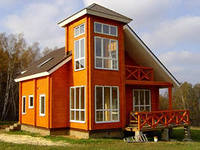 5.How and with what to properly paint a wooden house (outside)?
5.How and with what to properly paint a wooden house (outside)?
Previously painted wooden surfaces. If we see that the previously painted surface has faded, has a faded appearance, is covered in mold, the paint on the surface is peeling and other similar defects, then it’s time to think about updating the paint coating. A new coat of paint will significantly improve the appearance of the house, and at the same time you can also change the color of the facade itself. But before we begin the renovation, we must decide for ourselves what we want to get as a result? Indeed, often the very condition of the wooden surface limits us in choosing paint. It is worth thinking about repairing not the entire facade, but its individual parts, for example, the southern and western walls of the facade, which experience the greatest atmospheric loads and, accordingly, more often need repairs than other walls . Sometimes selective repairs are a good solution individual places or high-quality repairs one (the most worn) wall, with the intention of repairing the other walls next season. If the wooden facade is in good technical condition and does not have gross structural defects or damage, it can simply be updated by repainting it in the same or a different color. In the case of repainting, when choosing a new paint, it is better to adhere to the following rule: for repainting, use the same paint or the same type of paint that was previously painted on the surface. If we do not know what paint the surface was previously painted with, we will try to determine the type of paint previously applied. Types of paints can be determined visually. Acrylate paint has a leathery surface and chalks less and later than oil paint. Acrylate paint usually cracks in the direction of the wood grain, while oil paint has checkered or transverse cracking in the direction of the wood grain. You can conduct a simple experiment, try to roll up a small piece of paint. If the lacquer film remains intact, then this usually means acrylate paint, and if the film breaks with a bang, then it is most likely oil paint. Glazing antiseptics also wear out over time and their film becomes thinner. If we see a glossy film of antiseptic, then the surface can be repainted with the same antiseptic of a richer or darker color or with oil-based paint. If the antiseptic has completely faded and does not form a film, then the surface to be coated can also be painted with acrylate paint.
We paint the old surface covered with oil paint with oil paint or acrylate paint (after having previously cleaned the surface with a wire brush to the wood). We paint the surface covered with acrylate paint with acrylate paint or, if you really want, with oil paint (after cleaning the surface with a wire brush to the wood).
Preliminary preparation is important during repairs; how thoroughly it is carried out, the better and longer the coating will last. In such cases, the surface to be painted is usually cleaned of hanging scraps of old paint, dust, dirt, resin and foreign matter with a brush or scraper and washed with water. Mold is removed with a special solution. For better adhesion of paint on the surface, it is recommended to degrease the surface with alkaline detergents. Old sheathing, as well as rotten, crooked and cracked boards must be replaced with new ones. If you need to remove old paint, then remove it mechanically (sandblasting, scraper or metal brush) or chemically (using special compounds). Chemical removal of varnish coating better preserves the wood texture, but the process of chemical removal itself is difficult and slow, and to use it on large areas (in this case, facades) you need to be very patient. Chemical removal of old paint is used only when the surface to be cleaned must be cleaned very thoroughly or the condition of the wood does not withstand sandblasting. However, the end result of chemical removal is exceptionally excellent. In addition, it is necessary to do a trial removal of old paint. If you need to sand, then sand the wood. Next, we simply proceed according to the above plan. If we do everything as expected, we will get a good façade coating that will serve us for many years.
It is best to paint with a brush rather than a roller, as this is the highest quality painting method. At the same time, you should not apply too thick a layer, as this may result in uneven color and shine on the surface being painted.
Painting a wooden house may be necessary not only during the construction of a new building, but also for the restoration of an old one. If you notice that the facade of your house is peeling, the paint on it is cracked, or the wood has begun to darken, it’s time to undertake prompt “rescue work.” House painting is a convenient and inexpensive alternative to other exterior finishing options. In this article we will tell you how to choose the right materials and how to paint the outside of a wooden house.
|
Regular coat of paint on top wooden wall performs mass important functions, the main of which are: waterproofing, extending the service life of wooden elements and increasing the aesthetics of the building as a whole. Like any natural material, wood is subject to aging. The rate of aging is influenced by many factors, including ultraviolet radiation, water, pests and bacteria. Many people don't understand how sunlight can harm the tree and speed up its decomposition. But if you leave a piece of wood in the sun (not in the shade) for several weeks, the color will turn gray and the grain will become ruffled. Due to the drying of fibers and changes in their position, the wood becomes rougher and retains moisture (rain, snow, dew, fog). When saturated with moisture, the material swells, becomes damp and becomes an ideal breeding ground for fungi, mold, easy prey for wood-boring beetles, etc. As you can see, everything is interconnected, so the problem should be solved comprehensively, and special facade paints provide just such a solution. Paint selectionIn addition to good protective characteristics, paints for painting a wooden house must have durability, otherwise the coating will have to be renewed every year or every 2 years. The durability of the coating is affected not only by the composition of the paint, but also by the quality of surface preparation before application. But we will talk about this a little later, but for now we will determine what paint and varnish products are used to paint the walls of a wooden house.
Protective agents for exterior painting wooden houses:
The average service life is from 5 to 10 years. Acrylic paints are considered the most durable and high-quality - they protect wood for 10 years. In second place are alkyd paints and various antiseptics - 7 years. Oil paints last on average 6 years. But it should be taken into account that these are only approximate average indicators, depending on a host of factors. The best indicator of renovation will be the walls of your home, so once a year, inspect the façade for cosmetic repairs. Antiseptics for home protectionAntiseptic compounds are necessary to protect wood from bacteria, fungi, and mold. They prevent rotting and decomposition, thereby extending the life of a wooden structure. All antiseptics have a liquid consistency, which allows them to increase their penetration depth from 4 to 7 mm.
In addition to protecting against mold, antiseptics reduce the negative effects of atmospheric influences and create a suitable surface for coating with transparent tinting compounds, such as stain. The stain itself also has an antiseptic effect, but its main task is decorative tinting of wood. You will find more information about stain in the article "". There are glazing and coating antiseptics. Experts recommend using glazing compounds, as they are completely transparent and preserve the natural beauty of the wood. Covering antiseptics are opaque (hence the name from the word “to cover”), so they hide the wood texture, but at the same time preserve its relief. From this we can conclude that if you plan to cover the facade with transparent varnish, you need a glazing antiseptic, and if you are going to paint it any color, you can use a top coat. Acrylic paints for home coatingAcrylic paints have earned popularity due to their wide range of colors, ease of use and excellent performance characteristics. They are distinguished by enviable weather resistance, that is, they protect the tree from moisture, sun, and light mechanical damage.
An important advantage of all acrylic paints is their vapor permeability. Why everyone more people are they returning to traditions and building houses from wood, neglecting modern concrete materials? Because wood “breathes”, that is, it lets in fresh air and removes waste air, thereby ensuring constant micro-ventilation of the air. It is never too stuffy in a wooden house, unlike concrete or block buildings. And if you “wall up” the wood from the outside with an airtight material, you can lose a very significant advantage. Acrylic paint it does not interfere with the tree’s air exchange, but at the same time reliably protects it from moisture.
The paint is very elastic, which allows it to cover even the most complex shapes and not crack due to natural movements of wood (shrinkage of a new house, narrowing and expansion of wooden elements due to temperature changes). It is pleasant and convenient to work with acrylic, since it has almost no odor, and if it gets on the skin it does not cause harm (just wash off the paint with water). Brushes, rollers, and spray guns are used to apply paint. The drying time is very short, and if necessary, the coating can be renewed without removing the previous layer. Latex paints for home coatingLatex paints are generally considered one of the varieties of acrylic, but we decided to highlight them separately. If you go to the store, you will see that they are more expensive than regular acrylic facade paints, and the reason for this is their higher quality. Latex paints are also called rubber paints because they are highly elastic, and when applied they form a dense and opaque layer-film that firmly adheres to the wood and protects it from atmospheric influences.
The main advantage of this paint is its absolute environmental friendliness - even if it comes into contact with the skin, it is not capable of causing an allergic reaction. It is resistant not only to the manifestations of nature (ultraviolet radiation, rain, hail, hurricane gusts of wind), but also to various household chemicals, so it can be safely washed with alkaline solutions, keeping the facade of the house clean. Another point - after drying, latex paint forms a texture that is very pleasant to the touch. It fills all small cracks and chips, so it is ideal for restoring a house made of old, but not yet rotten wood. Glossy and matte latex paints are available for sale, but for facades it is better to choose matte ones, since gloss will highlight the smallest surface defects. Glossy paint will look good in a bathroom or kitchen on a perfectly flat and smooth wall. Oil paints for home coatingOil paints are highly weather resistant and have good penetrating ability. One could say that they combine the qualities of acrylic compounds and antiseptics, if not for one significant drawback - they dry very slowly. Drying time, depending on weather conditions, can take a day or more. In the case of a facade, this is not very convenient, since the wind can raise dust and “stick” it to the uncured paint. The same goes for foliage, insects, etc.
Also, over time, oil paint will fade and lose its glossy shine, but if you want to use light shades, this will be almost unnoticeable. Alkyd paints for wooden housesAlkyd paints were widely used during the Soviet era and many still find them the best in their field of application. But for the most part, they do not lose popularity due to their low cost. The facade will require a lot of paint, especially if the house is large, so if your renovation budget is limited, you can purchase alkyd paint. But before you go to the store, you should be aware of one feature - alkyd compositions are not very durable. They dry out quickly and cannot penetrate deep enough into the wood, and therefore begin to peel off over time. And if an alkyd coating will last 3-5 years, then a latex coating will last three times longer, and the cost will ultimately be approximately the same amount.
Basically, painting a wooden house with alkyd paints is carried out for window frames, door jambs, thresholds and other elements that require increased protection from moisture and temperature changes. By the way, these compounds can withstand temperatures down to -30C. You will find additional information on choosing facade paints in the article “”. Wood house painting technologyOptions for painting wooden houses depend largely on the chosen composition and condition of the wall surface. In this chapter we will describe all the manipulations that should be done with the facade so that the paint lays evenly, firmly and lasts as long as possible.
To work you will need:
Helpful advice: If you paint the facade with a brush or roller, stock up not only with a wide brush (roller), but also with a narrow or round brush for treating hard-to-reach places. If you choose a spray gun for work, keep in mind that the paint consumption for it is greater than in the case of a brush. A few words about the primer. In general, almost all paints adhere well to wood, and a primer is needed here more to enhance protection from moisture, rotting and better adhesion. An antiseptic will do an excellent job with this task, but if possible, it is better to first treat the surface with an antiseptic and then with a primer. For wooden houses, we can also recommend treatment with fire-retardant compounds that protect against fire.
To treat the end parts, use water-based sealants - they reliably protect these most vulnerable areas from moisture.
Work progress:
The colors of painting wooden houses can be very different. At the end of the article you will find a small photo selection interesting options decoration of facades using paint. When deciding on such an event, keep in mind that it is quite labor-intensive, and you will have to work alone for a week or longer. With two people, or better yet four people (one person on each side of the house), the painting can be completed in a few days. The video below shows the main points of painting the outside of a wooden house with your own hands: Painting wooden houses: photo
|
A wooden house is an environmentally friendly and comfortable housing, which is characterized by durability and reliability, aesthetic appeal and a cozy indoor environment.
But do not forget that wood is a living natural material. Therefore, it is susceptible to negative influences environment. This is high humidity and dampness, ultraviolet rays and insects, temperature changes and other harmful factors. During use, wood gradually ages, darkens or turns yellow and loses its original appearance.
Special protective and decorative compounds for treating walls will help preserve wood. In this article we will look at how to paint the outside of a wooden house. Painting the external walls of a wooden house is a mandatory stage in the construction and finishing of a country log home!
It is necessary to paint a house not only after construction and shrinkage, but also during operation. Experts recommend painting wooden buildings once every 5-8 years, depending on the type of paint and varnish materials, and it is advisable to treat an old house more often.
Which painting products to choose
Today, manufacturers offer various paints and varnishes. For external wood processing, resistant and rough compounds are suitable. Let's look at which ones are best to use for a log house.
Antiseptic varnishes come in glazing (transparent) and covering (opaque) varieties. The first type saves natural color and emphasizes the texture of the wood, while the second will help achieve the desired shade and shine. Such products penetrate deep into the wood and protect the material from rot and mold, the negative effects of water and humidity. When choosing, please note that coating compositions will last 6-7 years, but glazing varnish will have to be renewed every 4-5 years.
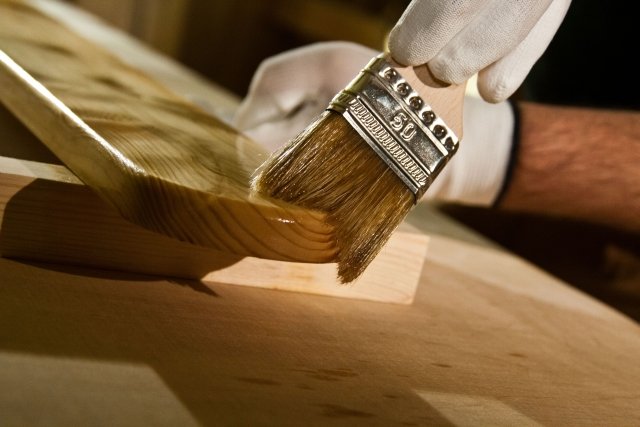
Acrylic (acrylant) paints are the most popular products among owners country houses. They are best suited for natural wood as they are absolutely safe. Such paints allow the wood to “breathe” and guarantee good air exchange. The acrylic composition creates an elastic, dense coating that protects the wood from moisture, cracking and fungus.
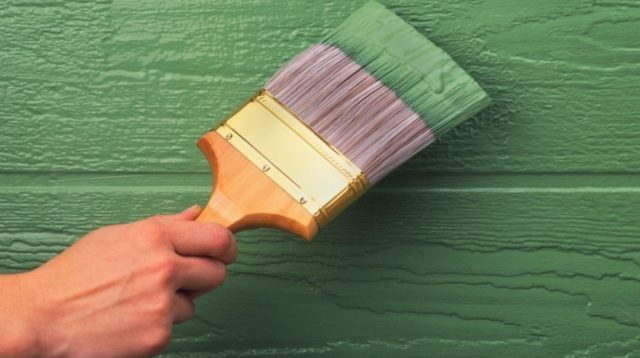
Acrylic paints are expensive, but they create a durable and reliable coating that will last a long time. You won’t have to renew your paint more often than once every 8-10 years!
Oil paints are well absorbed and penetrate deep into the wood structure. They effectively protect log walls from dirt and moisture. But today such products are losing popularity because they take a long time to dry. In addition, over time, painted wood changes color and shade, and yellow spots appear on the surface. To avoid this, you will have to repaint more often than every four years.
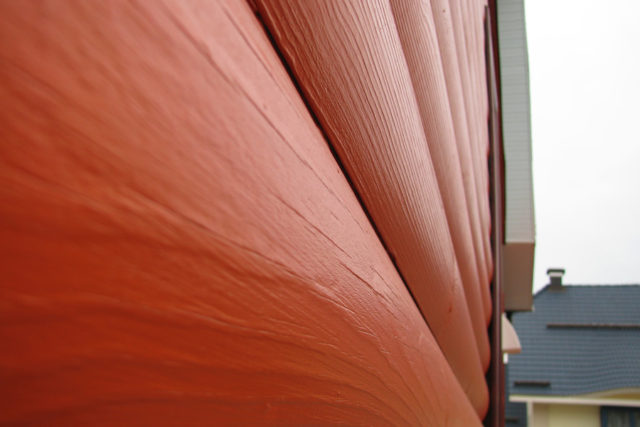
Yacht varnish is best suited for regions with high rainfall and high humidity. He gives reliable protection from changes in temperature and moisture. This varnish does not fade and prevents the appearance of yellowness on the surface. The product is durable, but when painted it emits an unpleasant odor.
Using wax or stain is an old, tried-and-true method for painting your home. Wax is a natural and safe product that will not disturb the environmental friendliness of a wooden structure. It is deeply absorbed into the material and effectively protects log walls from dirt and moisture. After waxing, the surface will become translucent with a matte shine.
Stain is the cheapest and most accessible option for treating a home, both outside and inside. It will also protect the tree from pests and fungus, while preserving the pattern and color of the logs. But after staining, you must apply varnish to enhance the properties and increase the service life of the material.
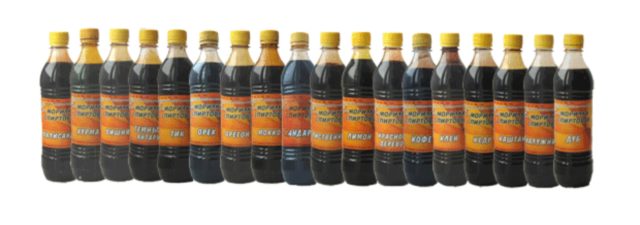
In addition to the type of paint or varnish, it is important to choose the right color. You can choose transparent compounds to preserve the structure and color of the log, choose a darker or lighter shade, matte or glossy sheen. In addition, today there are also means for painting a wooden house with colors that have nothing to do with the color of the wood.
You can paint the house purple, green, red and any other colors. It all depends on your preferences. Designers recommend using warm shades in northern latitudes and cold regions of the country. And in warm regions, on the contrary, use cool colors.
If you cannot find the right materials, turn to professionals for help! Experienced experts of the MariSrub company will select high-quality products and calculate the volume of paint, reliably and quickly paint a wooden house, bathhouse or gazebo. Let's find out how to properly paint a wooden house.
The best facade paints for wood
| Brand | Description | Advantages | Price |
| Tikkurila (Finland) | Most Popular Funds Raised positive reviews both professional craftsmen and ordinary owners of wooden houses | High water-repellent properties; wide range; good frost resistance | from 600 rubles for 0.9 l |
| Senezh (Russia) | High-class antiseptic and renewing compositions suitable for baths, homes and gazebos, with a large selection color range(16 colors and shades) | Difficult to wash out and compositions with a service life of 10 years; protection not only from moisture and pests, but also from the spread of fire during a fire | from 240 rubles for 0.9 kg |
| Drevoplast (Russia) | A durable acrylic emulsion that creates a durable decorative coating on the surface of the walls and gives the effect of “liquid plastic” | High resistance to precipitation and humidity, easy application, long-lasting protection | from 350 rubles for 0.9 kg |
| Tex (Russia) | Universal inexpensive paint for exterior work, which creates a durable polymer film on the surface of the walls | High vapor permeability, resistance to light and ultraviolet radiation, fits well on walls | from 300 rubles for 0.9 kg |
| Pinotex (Estonia) | Polymer-based decorative products for exterior painting of the facade of a house, gazebo or bathhouse, fences and fences, wooden canopies | Protects against mold and moisture, fungus and insects, withstands sudden temperature changes | from 490 rubles per 1 l |
| Olympus (Russia) | Elastic emulsion based on flax oil for new and old surfaces, suitable for wooden facades, garden furniture, ceilings and floors inside the house | Versatility; strengthens wood and does not crack, protects against moisture and insects, mold and mildew |
from 200 rubles for 0.9 kg |
How to paint a house
- The initial stage is preparing the walls. Remove dust and dirt from the logs, level the surface if necessary;
Then a primer is applied to the surface. It will protect the walls from mold, blue stains and fungus. Without a primer, after two years the house will have to be painted again; - After the primer has completely dried, proceed to painting. Remember that you can only paint dry wood and in dry weather! If you are using oil paints that take a long time to dry, it is advisable that there is no rain in the next few days. Therefore, before the procedure, check the weather forecast;
- It is better to paint with a roller and brush, since when using a spray gun it is difficult to obtain a perfectly even, smooth and painted coating, especially if you have little experience in painting;
- Before coating, thoroughly stir the paint composition;
- The paint is applied with a roller evenly in two or three layers. It is better to use a brush for painting hard-to-reach places. Some companies produce special paints with enhanced protective composition for ends and corners, since these places are most susceptible to the negative effects of moisture;
- Apply each new layer only on the dried previous layer. This takes 3-4 hours; Stir the composition of the paint and varnish periodically;
- The last layer of paint is applied from top to bottom in a thin layer;
- Finally, the paint can be coated with clear varnish. This will consolidate the result, increase the service life of the coating and better protect the wood. But you can get by with just one paint.
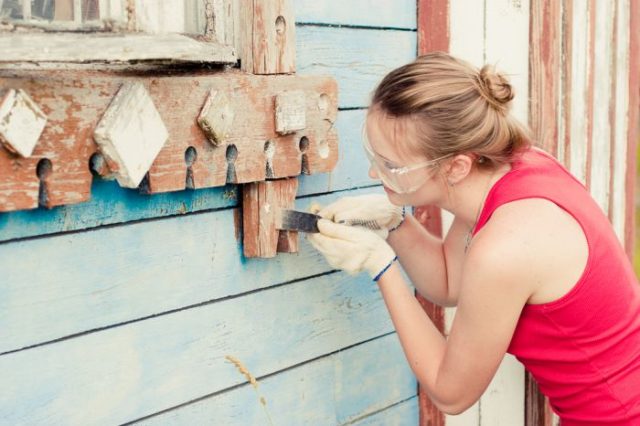
How to paint an old house
Remember to renew the paint at intervals depending on the type of paint or varnish. Before painting, it is important to carefully prepare the old house for the procedure. When repainting, experts recommend using the same type of product that was used previously.
After purchase necessary materials The old paint coating is removed from the surface of the logs and dirt is removed. Mold is removed with a special solution and the damaged areas are additionally treated with an alkaline detergent. It is better to replace old, crooked and rotten boards with new ones.
Sand the walls if necessary. How to properly sand walls, read the link http://marisrub.ru/uslugi/rabota-so-stenami-doma/shlifovka-sten. After preparatory work Painting is carried out according to the same scheme as painting a new wooden house. If you have any problems painting your house, contact the MariSrub company!
Wood houses appeared long before it became a trend in modern construction. Wood has minimal thermal conductivity, which has a good effect on thermal insulation and performance characteristics.
But at the time of the first wooden buildings, few people understood that such material required additional protection. Thus, most cultural monuments have not survived to modern times.
In this article we will consider in detail the question: what can you use to paint wooden houses?
Causes of wood aging
Initially, it is important to understand why wood undergoes destruction. Initially, it is a living material, which in any case undergoes aging, just like a person. Therefore, in order to extend its service life as much as possible, you need to take care of the appropriate treatment of your home.
Another reason is the natural effect on the tree:
- Sun.
- Mold.
- Fungus.
- Insects and so on.
Such natural factors destroy the original properties of wood, and as a result, the material becomes coarser, grayness appears, and the fibers lose their former strength. Such negative processes can be noticed in the first weeks after the construction of the facility.
Precipitation also has an adverse effect on wood - the material simply swells. When drying, a reverse reaction occurs.
As a result of such changes, cracks may appear in which fungus develops well. The resulting mold develops inside and is very difficult to notice.
Another cause may be bark beetles. Such pests can quietly remain dormant in the house for three years, and you will not even know about their presence. But when they become active, your building can suffer greatly.
The next reason is atmospheric loads on the building, which is located in the coastal zone or on open place. The closer a house is to moisture, the faster it will age and, accordingly, collapse. The northern part of the structure is less susceptible to damage than the southern and western sides.
As you noticed, there are plenty of reasons for wood to age, but don’t be upset. There are also plenty of different techniques and methods for protecting wood.
Preparing the house for painting
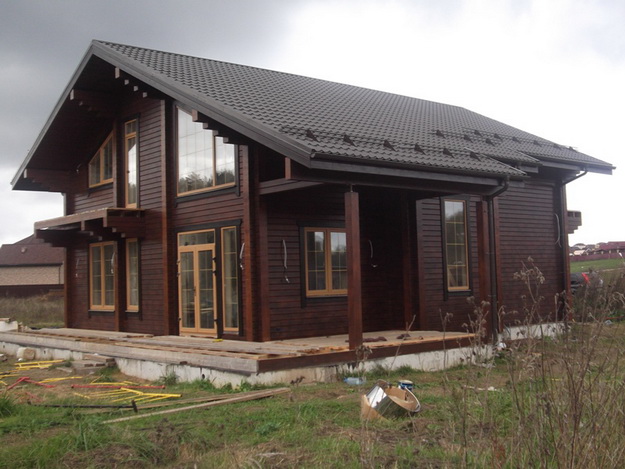 Before starting paint work at home, special preparation of all surfaces will be required. After all, you will not be working with bricks, but with living material. Proper preparation will improve paint adhesion to wood and significantly extend the performance of your home:
Before starting paint work at home, special preparation of all surfaces will be required. After all, you will not be working with bricks, but with living material. Proper preparation will improve paint adhesion to wood and significantly extend the performance of your home:
- Take a garden sprayer and, together with a brush, remove dust and various small dirt from the tree. Moisture absorbs dust well - this is much better than simply treating wood using a brush.
- If there is blue stains or mold, remove it all with Tikkurila.
- It is recommended to remove resin residues with a metal spatula. After removal, treat the areas with knot varnish to ensure a smooth surface.
- Coat metal parts with a primer that is intended for the intended use.
- Upon completion of all work, allow the tree to rest for 14 days. To do this, cover it with film. Don't forget to leave holes for ventilation. If the weather is warm, then you don’t have to cover the tree.
- If the wood is damp and it is not possible to dry it, then apply a primer-type antiseptic to the damp material. After this, wait until you can dry the house.
By using all the preparation guidelines, you will lay a good foundation for painting your house. This way, the coating will last much longer, which is exactly what you need. Now you should move on to choosing the paint to use.
What can you paint with?
There are three types of coatings for the chosen purpose:
- antiseptic;
- acrylate paint;
- oil paint.
An antiseptic is a coating that has very good penetration ability. The depth can reach seven millimeters. This product reliably protects the wood from various atmospheric loads, as well as from rot and mold.
Antiseptics can be glazing or coating. The first ones are a transparent coating, which means that your home will retain the original wood grain with a noble shade.
Opaque antiseptics completely hide the wood structure, but preserve the relief of the material.
Acrylate paints have high weather resistance. The appearance of such a coating is preserved for a fairly long period of time. Paint allows the material to breathe - this means that the house will be alive. Acrylate in the paint makes the product elastic, which avoids cracks and all kinds of damage.
Oil paint also has good weather resistance. In terms of absorption, the coating is comparable to antiseptics.
The only significant drawback is the long drying time, which can take a day or more. In addition, over time the surface oil paint prone to discoloration, and it can also become matte. Such a defect is not noticeable only on light colors.
We hasten to warn you that paint of any quality and cost will require updating over time. You can see this for yourself in the following list:
- antiseptics last up to 5 years, and the figure varies both up and down;
- coating antiseptics – service life up to 7 years;
- acrylate paint can last up to 10 years;
- oil paint – up to 6 years.
All figures are approximate; after painting the house, you will immediately notice the moment when the coating loses its original appearance.
The process of painting a wooden house
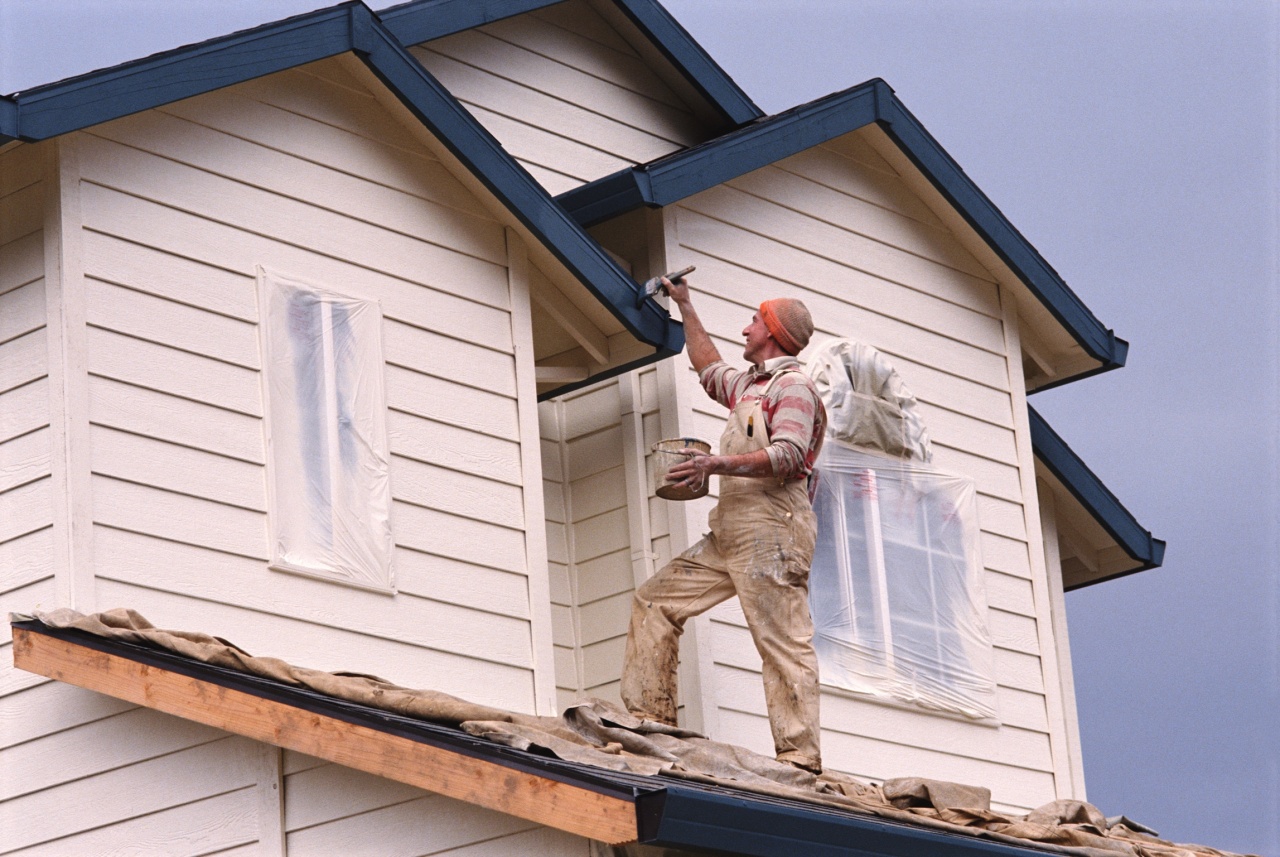 You do not need any special skills in this matter, but you should observe several nuances when performing such work:
You do not need any special skills in this matter, but you should observe several nuances when performing such work:
- Primer. It is important to use a primer antiseptic in order to protect the material from the appearance of fungus, blue stains or mold. If you miss this point, then in two years you will most likely need to repeat the entire painting job and pay double the cost for it all. You should not initially skimp on using an antiseptic - it significantly extends the life of the paint.
- Paint should be applied to a dry surface in several layers. Each layer must be dried.
- Several rules for applying paint to wood.
- Stir the paint periodically. Thus, the shade of the coating will be the same.
- Apply paint with a brush. Only with this method can a uniform color be achieved. Don't overdo it with paint.
- For high-quality painting, you can use a primer color. In this case, the color will be simply exceptional.
- Do not paint in very hot weather under the scorching sun. The paint will dry faster than expected and the quality of such a coating will leave much to be desired. The most suitable conditions for painting work are calm, warm and slightly cloudy weather.
- The process of applying antiseptic and paint should be longitudinal.
- The end areas of logs and boards must be carefully treated with several layers of primer and coating material. This way, you will protect these parts of the house from quickly absorbing moisture and stop the process of rotting.
The process of painting an old house
If your house was built a long time ago, and there is mold on the wood, the paint is falling off and other unpleasant defects are visible - think about painting your home. Fresh paint will not only update the appearance of the facade, but will also allow you to experiment with the future color.
Before you start painting, thoroughly examine the entire surface of the house. Maybe something has fallen off somewhere and requires prompt repair. The western and southern facades lose their good appearance faster than others.
You may need to paint only those areas that have seen significant wear, or you may decide to completely paint and completely change the color of the building. For painting, use either the same paint that was used previously (according to the manufacturer), or a coating of the same type.
